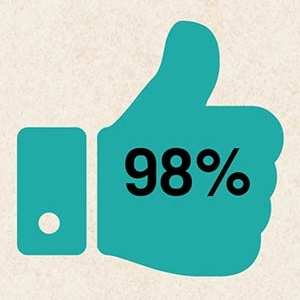Results of the IAPM certificate Holder Survey 2015
 20.10.2015 -
IAPM Certificate Holder Survey 2015
20.10.2015 -
IAPM Certificate Holder Survey 2015Almost one-quarter of IAPM certificate holders have experienced positive effects on their careers after certification
The IAPM International Association of Project Managers conducted a survey of its certificate holders in March and April 2015 and we’d like to present the results to you today. We’ve compiled them all in chart format for you. You can download them here: www.iapm.net/uploaded_files/documents/certificate-holder-survey-2015-en.pdf
As in 2013, we conducted an anonymous survey of project managers about their professional situation, their training-related needs and their satisfaction with the IAPM. In 2015 122 certificate holders filled out the survey - and, once again, the certificate holders are very satisfied with their association. 97 percent said that they would recommend the IAPM to other people and 64 percent have already done so.
Personal and career history
The responses in this section of the survey reflect the realities of the occupation of project manager. Most people start their project management career in their 20s, and from the age of around 45 many of them move on to other things. Most of the respondents were aged between 35 and 44. The majority earn annual salaries in the region of EUR 80,000 and over 20 percent earn over EUR 100,000 a year. Most project managers are employed at large-scale corporations (59 percent of respondents).
The responses didn’t indicate any single sector with a disproportionately high number of project managers.
Certification in companies
Although agile project management is growing in popularity, the “traditional” certifications are still the most popular. 60 percent of respondents who are project managers with IAPM certifications are Certified Senior Project Managers, and around one-quarter are Certified Project Managers. It is clearly evident that project managers are committed to project management quality and better career opportunities, because 83 percent of respondents stated one of these reasons as their main motivation for obtaining certification. Around three-quarters of respondents were certified at their own initiative. Vice-versa, certification is mandatory at the companies where 17 percent of respondents work.
Preparation for the certification examination and consequences of certification
Almost half of the surveyed IAPM certificate holders prepared for the certification examination by attending a classroom course and almost 20 percent used the IAPM’s PM Guide 2.0. Over 50 percent spent up to 14 days learning for the examination, and 35 percent spent between 15 and 30 days. Only 14 percent of respondents needed more than 30 days to prepare, and 98 percent passed the examination at the first attempt.
24 percent of certificate holders experienced positive career changes such as a higher salary or a better position at the company after obtaining certification.
Agile project management is still increasing in popularity
Almost half of the respondents said they had already worked in an agile project environment. This indicates that agile and hybrid project management methods are becoming even more widespread. 12 percent of respondents were not sure whether they had worked with agile methods, which indicates further need for education and improvement in this segment despite all the efforts that have already been made.
Just over half of the respondents predominantly work in national projects, and 31 percent stated that they predominantly work in international projects. The remainder work in both types of projects to a more or less equal extent. Therefore, around one-third of project managers with IAPM certification mainly work in international projects, whereby the preparatory training for Certified International Project Manager certification and the subsequent certification procedure can be very useful to them.
Classroom training beats e-learning
Although e-learning is on the increase in many sectors, including the higher education sector, only 17 percent of respondents stated that they prefer this type of learning as compared to a preparatory course with a project management trainer. 54 percent of respondents were, however, prepared to pay for e-learning courses that deliver good results. Almost one-third were undecided on this point, and 28 percent have never taken an e-learning course.
The IAPM profits from its network philosophy
Around 20 percent of respondents found out about the IAPM through online advertising or presence in social networks. Almost half of the certificate holders found out about the IAPM through a personal recommendation, and another quarter first encountered it in preparatory training courses.
The recommendation rate for the IAPM is very high: 97 percent said that they would recommend the IAPM to other people and 64 percent have already done so.
We’d like to thank all survey participants and our certificate holders, and look forward to sharing the IAPM’s network philosophy with them.

« Back to overview
